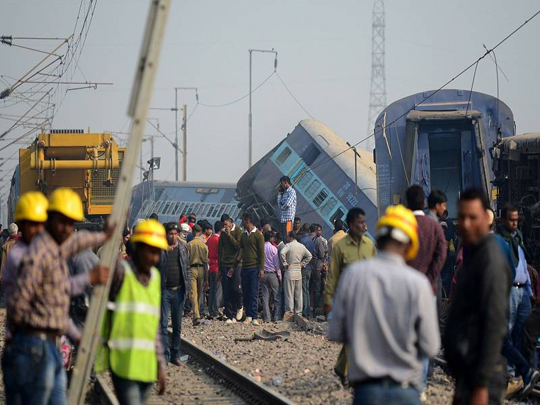Patna/Delhi, Jan 18: Two major train accidents near Kanpur which resulted in deaths of 151 passengers and injuries to 200 others, were carried out on the instructions of Pakistan's external spy agency ISI, according to the Bihar police.

The ISI hand was exposed following the arrest of three criminals Umashankar Patel, Motilal Paswan and Mukesh Yadav from Motihari on the Indo-Nepal border who were working at the instance of an ISI agent, a Nepalese citizen based in Dubai.
"These criminals were arrested for their involvement in placing a cooker bomb on the railway track near Ghorasahan in the district on October 1 last year. They have confessed to having worked for an ISI agent," district SP Jitender Rana told TOI over phone, adding one of them confessed to his involvement in planting explosives to derail the Indore-Patna Express and Ajmer-Sealdah Express trains near Kanpur last year.
The disclosure marks a new dimension of the subversion carried out by ISI, and has exposed the vulnerability of railways to terrorists. With the case throwing up clear external linkages with conspirators based in Nepal, Pakistan and UAE, the NIA is closely following the investigation by the Bihar police.
"Our team of investigators are in touch with the local police and will examine the disclosures made by the arrested accused. If our preliminary conclusions vet the ISI-link theory, there is a possibility of NIA taking over the investigation," said an NIA official.
Those involved in the plot could have killed many more if they had succeeded in derailing a passenger train by setting off an explosion on a rail track. Also, a major train accident was foiled on January 1 by the railway patrolling staff, who detected that 50 elastic rail clips and three pairs of fishplates were removed and deliberate damage caused by a hacksaw on the track between Kalyanpur and Mandhana stations in the Farrukhabad-Kanpur Anwarganj section.
Railways has already asked CBI to inquire into the incident which happened a day before Prime Minister Narendra Modi was scheduled to address a political rally in Lucknow.
"Fortunately, the bomb at Ghorasahan was detected with the help of villagers and defused," Rana said about the attempt by the trio to cause an accident in East Champaran district of Bihar on October 1 last year.
Passengers of the Indore-Patna Express were not so lucky. At least 151 were killed when the train flew off the track on November 21 last year. Just over a month later, more than 50 people were injured when Ajmer-Sealdah Express derailed, again near Kanpur, on December 28.
Rana said the trio had received around Rs 3 lakh till now from Brij Kishore Giri for engineering train accidents. Brij is a Nepali citizen. He along with Shambhu Giri and Mujahir Ansari was arrested by Nepal police recently. "The Nepal police have shared vital information with us regarding their ISI links," Rana said, adding that the state ATS (anti-terrorism squad) and other security agencies have been informed about their confession. RPF is also in touch with the Bihar police and is coordinating efforts to reach the bottom of the conspiracy.
Rana said Motilal was earlier a Maoist operating in Adapur block of East Champaran district. "Umashankar has at least four criminals cases against him while 12 cases are lodged against Motilal and Mukesh," the SP said, adding investigations were on to gather information on the main handler of the gang.
Police officials are verifying if Motilal was the area commander of an extremist group, an assumption which if proved correct, will suggest that concerns over ISI enlisting local disaffected groups may have come true.
Sources said Motilal told police he had planted explosives on the tracks near Kanpur for derailing the two trains. "Brij had received funds from Dubai for the purpose. Brij had promised flats, vehicles and finances to produce a Bhojpuri movie to the trio arrested from Motihari," said a police officer involved in the interrogation.
Police have now launched a manhunt for two others, identified as Gajendra Sharma and Rakesh Yadav, who are said to be hiding in East Champaran, the sources said.
Incidentally, Indian Mujahideen chief Yasin Bhatkal was arrested from Raxaul in East Champaran district in August 2013.








Comments
Agencies gathering some stuff to capitalize in coming election.
Keep on telling false so that other person can feel that you are telling the truth.
Add new comment